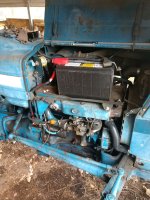sweetskillsrk
Member
I'm doing some winter maintenance and updates on my 3000 gasser and I would like a few pieces of advice.
The previous owner took out the original fuel lines between the tank and the short tube at the carb, including the fuel bowl/screen. He replaced it with an in line fuel filter and a couple rubber hoses (see picture). I have a decent fuel bowl/screen assembly from my parts 3400. Should I replace the in line filter with the original setup? On the occasion, the tractor does bog down and the RPMs fluctuate significantly, almost shutting off. I always thought it was the carb or junk in the fuel tank, but after reading a bunch of other posts, could the in line filter be part of my problem? I've read about fuel flow tests on other posts and I haven't done that yet, probably should to verify where the issue could be.
I'm going to add the neutral safety switch back into the system (it was removed by the PO as well). I have what I believe to be a good switch and wire set from the 3400. It looks like it has continuity when the ball bearing is in and there is no continuity when it's further out. Is that correct? Looks like there's a couple dimples in the hi/low shaft so the ball slides into one of those and thus loses continuity when the tractor is in gear. Makes sense to me, just verifying.
I'm going to finally change the hydraulic and rear end oil. I have a big Ford tractor service manual, but I can't find anything about doing fluid changes? I believe the plug is directly below the seat on the bottom of the center axle housing and the level plug is the square one on the right. I've read it takes anywhere between 6 gallons and 8 gallons?
I would like to keep a spare coil on hand, but I can't figure out which one I need to go with. The whole internal or external resistance is confusing me. I've read a lot of posts but don't understand the end goal of the resistor in this case.
Thanks in advance!
The previous owner took out the original fuel lines between the tank and the short tube at the carb, including the fuel bowl/screen. He replaced it with an in line fuel filter and a couple rubber hoses (see picture). I have a decent fuel bowl/screen assembly from my parts 3400. Should I replace the in line filter with the original setup? On the occasion, the tractor does bog down and the RPMs fluctuate significantly, almost shutting off. I always thought it was the carb or junk in the fuel tank, but after reading a bunch of other posts, could the in line filter be part of my problem? I've read about fuel flow tests on other posts and I haven't done that yet, probably should to verify where the issue could be.
I'm going to add the neutral safety switch back into the system (it was removed by the PO as well). I have what I believe to be a good switch and wire set from the 3400. It looks like it has continuity when the ball bearing is in and there is no continuity when it's further out. Is that correct? Looks like there's a couple dimples in the hi/low shaft so the ball slides into one of those and thus loses continuity when the tractor is in gear. Makes sense to me, just verifying.
I'm going to finally change the hydraulic and rear end oil. I have a big Ford tractor service manual, but I can't find anything about doing fluid changes? I believe the plug is directly below the seat on the bottom of the center axle housing and the level plug is the square one on the right. I've read it takes anywhere between 6 gallons and 8 gallons?
I would like to keep a spare coil on hand, but I can't figure out which one I need to go with. The whole internal or external resistance is confusing me. I've read a lot of posts but don't understand the end goal of the resistor in this case.
Thanks in advance!


